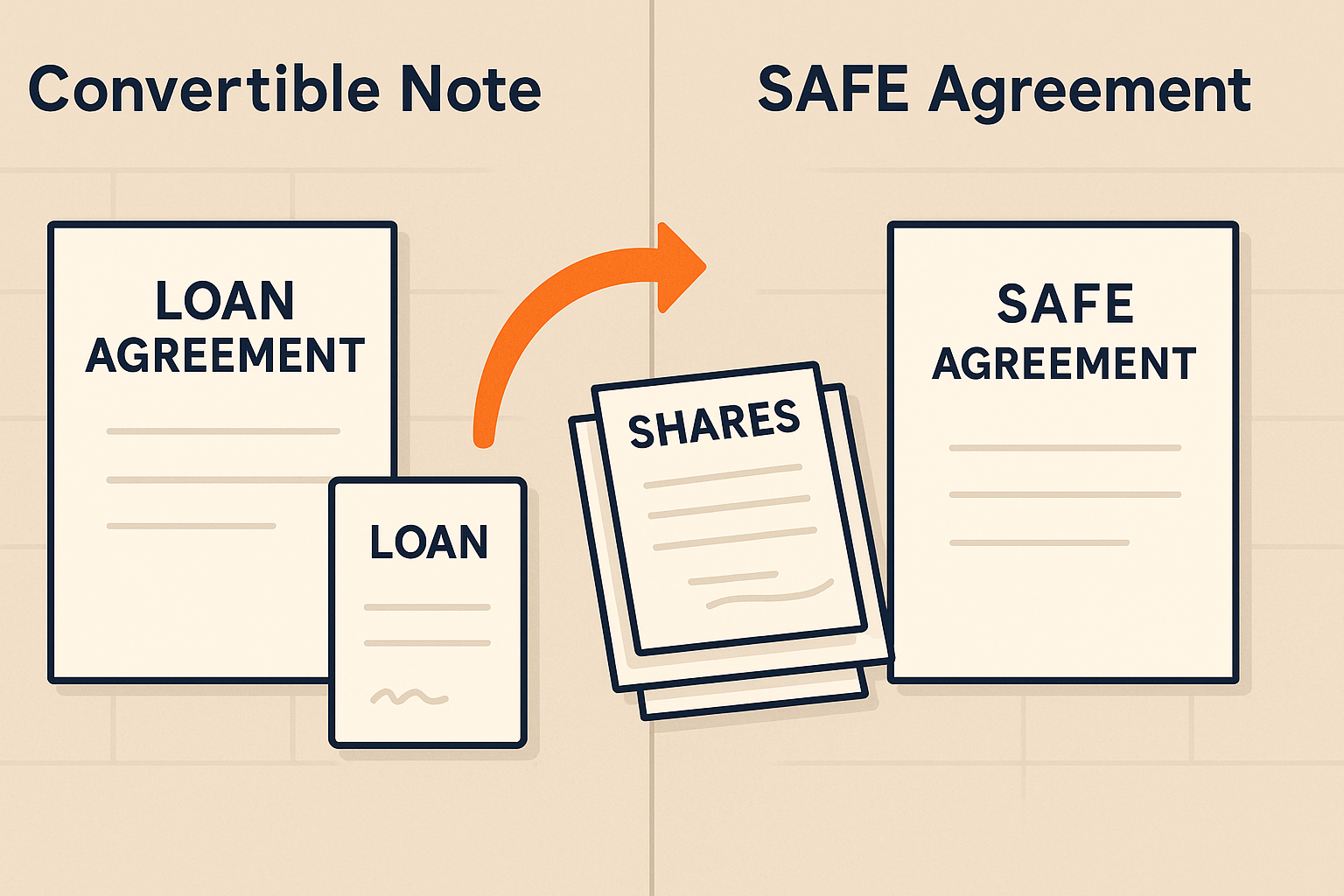1 (800) 584-0324
Early-stage startups often need capital before they’re ready for a full priced equity round. Instead of negotiating complex valuations, many turn to convertible notes and SAFE agreements. These flexible financing tools let founders raise quickly, while giving investors the right to equity later.
This guide breaks down how a convertible note SAFE agreement works, key differences, pros/cons, and when to use each.
What Is a Convertible Note?
A convertible note is short-term debt that converts into equity in a future financing round.
Key features:
- Loan structure: Starts as debt with interest (typically 5–8% annually).
- Conversion trigger: Converts into preferred equity when the startup raises its next round.
- Valuation cap: Maximum valuation at which the note converts (protects early investors).
- Discount rate: % discount (e.g., 20%) to reward early risk-taking.
- Maturity date: If no conversion, lender can request repayment or negotiate equity.
✅ Best for startups raising from early angels who want debt-like protections.
What Is a SAFE Agreement?
A SAFE (Simple Agreement for Future Equity) was created by Y Combinator in 2013 as a founder-friendly alternative to convertible notes.
Key features:
- Not debt: No interest or maturity date.
- Conversion trigger: Converts to equity in a future priced round.
- Valuation cap & discount: Same protective features as convertible notes.
- Flexibility: Cleaner, shorter contracts with less legal complexity.
✅ Best for founders who want simplicity and no repayment obligations.
Convertible Note vs SAFE Agreement
| Factor | Convertible Note | SAFE Agreement |
| Structure | Debt (with interest & maturity) | Equity contract, not debt |
| Repayment Risk | Yes, if no round occurs | None—no maturity obligation |
| Valuation Cap/Discount | Common | Common |
| Investor Protections | Stronger (creditor rights) | Weaker (no debt leverage) |
| Founder Burden | Higher (interest + repayment risk) | Lower (simpler, no maturity) |
| Legal Complexity | More expensive to draft | Standardized, cheaper |
Pros and Cons of Convertible Notes
Pros:
- Protects investors with interest + maturity date
- Familiar to angels and early-stage investors
- Incentivizes quick follow-on funding
Cons:
- Adds debt to the balance sheet until conversion
- Creates repayment risk if no priced round happens
- More legal complexity than SAFEs
Pros and Cons of SAFEs
Pros:
- Simpler, cheaper, and faster to execute
- No debt or repayment pressure
- Founder-friendly, keeps balance sheet clean
Cons:
- Less investor protection (may deter conservative angels)
- Can create complex cap tables if used across multiple rounds
- Some investors prefer notes for negotiating leverage
When Should Startups Use Each?
- Convertible Note:
- Investors are risk-averse and want debt protections
- Uncertainty about when the next priced round will occur
- Bridge financing scenarios
- Investors are risk-averse and want debt protections
- SAFE Agreement:
- Pre-seed or seed rounds with friendly investors
- Founder wants speed, simplicity, and no repayment risk
- Common in tech/startup hubs (e.g., Silicon Valley, Toronto, NYC)
- Pre-seed or seed rounds with friendly investors
U.S. vs Canada Context
- U.S.: SAFEs are widely adopted, especially in Y Combinator and other accelerator-backed startups. Convertible notes remain popular outside tech hubs.
Canada: Convertible notes are more common, though SAFEs are gaining traction as venture ecosystems mature. Securities laws vary by province, making notes familiar for legal teams.
Considering a convertible note SAFE agreement for your next raise? Agile Solutions helps startups structure founder-friendly terms, model dilution, and negotiate with angels or early-stage funds in the U.S. and Canada.
👉 Book a consultation today at agilesolutions.global or email us at info@agilesolutions.global
#ConvertibleNote #SAFENote #StartupFunding #AngelInvestors #VentureCapital #SeedRound #FundraisingStrategy



